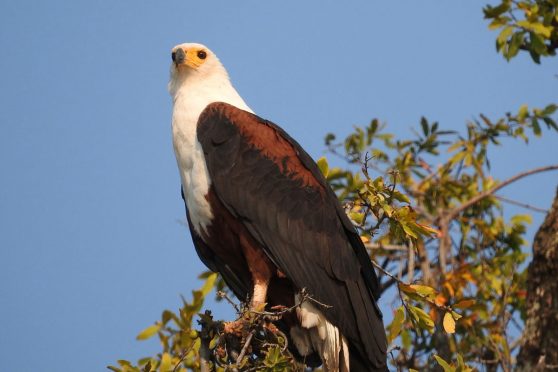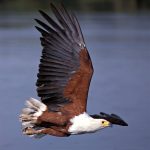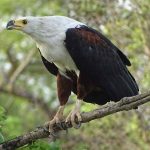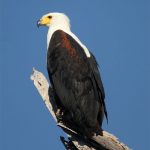African fish eagle (Haliaeetus vocifer)
| Name: | African fish eagle |
| Scientific Name: | Haliaeetus vocifer |
| Other Names: | African Fish Eagle, African Sea Eagle |
| Habitat: | Lake, river, creek |
| Size | |
| Length: | 26–33 Inch |
| Width: | 4–6 lbs |
| Wingspan: | 7 Inch |
| Nesting: | |
| Voice: | |
| Social Behaviour: | |
| Migration: | Partial Migrant |
| Lifespan: | Up to 15 years in the wild |
| IUCN Conservation Status: | Least Concern |
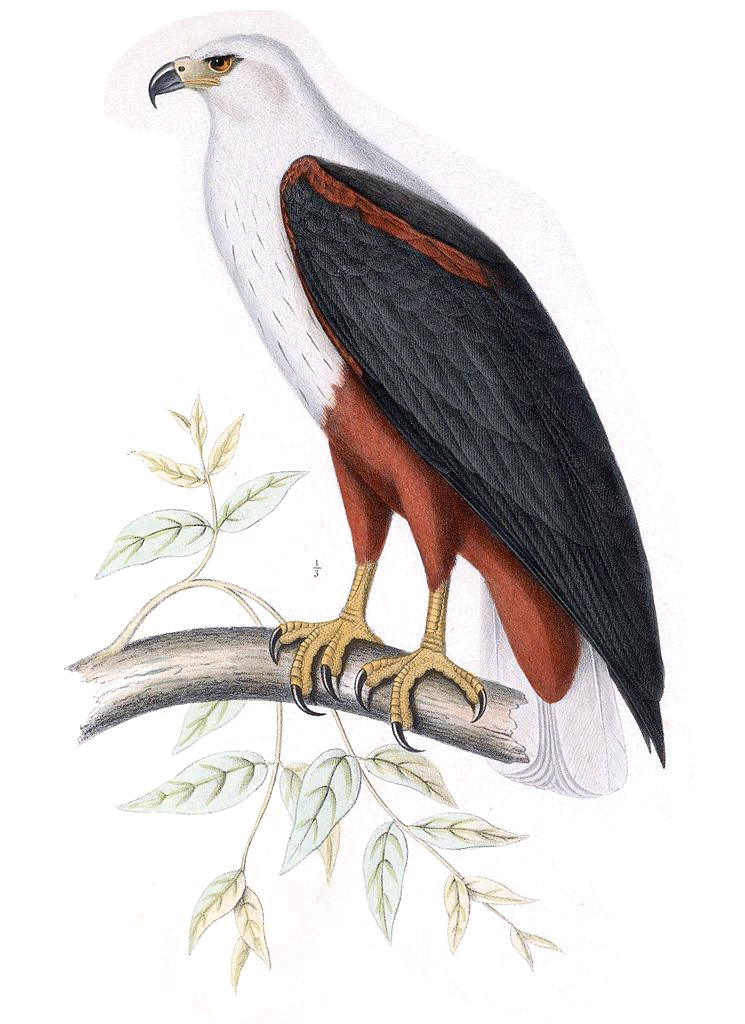 Scientific Name:
Haliaeetus vocifer
Scientific Name:
Haliaeetus vociferScientific Classification:
| Kingdom: | Animalia (Animal) |
| Phylum: | |
| Subphylum: | |
| Class: | |
| Order: | |
| Family: | |
| Genus: | |
| Species: | Haliaeetus vocifer (African fish eagle) |
The African fish eagle (Haliaeetus vocifer), or to distinguish it from the true fish eagles (Ichthyophaga), the African sea eagle, is a large species of eagle found throughout sub-Saharan Africa wherever large bodies of open water with an abundant food supply occur. It is the national bird of Namibia, Zimbabwe, Zambia, and South Sudan. As a result of its large range, it is known in many languages. Examples of names include: visarend in Afrikaans, nkwazi in Chewa, aigle pêcheur in French, hungwe in Shona, and inkwazi in isiZulu. This species may resemble the bald eagle in appearance; though related, each species occurs on different continents, with the bald eagle being resident in North America. (1)
After awakening the continent with its song, the African fish eagle strikes quickly to land its daily meal, then retires to its perch to closely guard its territory from intruders.
Skull: The skull is lightweight, with reduced jaws, large eye sockets and no teeth, for better flight efficiency.
Juvenile: Lacking full adult plumage, the brown, immature eagle is often confused with the osprey and palm-nut vulture.
Bill: The very powerful hooked beak is rarely used for killing. Instead, it shreds and tears prey into smaller pieces.
Feet: The rough spicules on the soles of its bright yellow feet help the African fish eagle grip its slippery prey.
Names in other language:
| Afrikaans: | Visarend |
| Arabic: | عقاب السمك الأفريقي (African Fish Punishment) |
| Belarusian: | Арлан-крыкун (Arlancryk) |
| Breton: | Morerer Afrika |
| Catalan: | Pigarg Africà |
| Czech: | Orel Jasnohlasý |
| English: | African Fish Eagle, African Sea Eagle |
| Esperanto: | Afrika maraglo |
| Esperanto: | Afrika maraglo |
| Estonian: | Kilg-merikotkas |
| Estonian: | Kilg-merikotkas |
| Finnish: | Kiljumerikotka |
| French: | Aigle pêcheur, Pygargue vocifère, Pygargue vocifer |
| German: | Schreiseeadler |
| Hebrew: | עיטם קולני (A loud eagle) |
| Hungarian: | Lármás rétisas |
| Icelandic: | Glymörn |
| Italian: | Aquila pescatrice africana |
| Japanese: | サンショクウミワシ (Anchovy fish) |
| Latvian: | Skaļais ērglis |
| Lithuanian: | Afrikinis jūrinis erelis |
| Malayalam: | ആഫ്രിക്കൻ മീൻപിടിയൻ പരുന്ത് (An African fishing boat) |
| Mongolian: | Африк нөмрөг бүргэд (African cloak eagle) |
| Navajo: | Naakaii Łizhiní Bikéyahdę́ę́ʼ atsáłgaiitsoh |
| Norwegian: | Flodørn |
| Norwegian Nynorsk: | Flodørn |
| Persian: | عقاب دریایی آفریقایی (African sea eagle) |
| Polish: | Bielik afrykański |
| Portuguese: | Pigargo-africano |
| Russian: | Орлан-крикун (Trencher Creek) |
| Shona: | Hungwe |
| Slovak: | Orliak jasnohlasý |
| Slovenian: | Afriški jezerec |
| Spanish: | Pigargo vocinglero |
| Swahili: | Furukombe wa Afrika |
| Swedish: | Skrikhavsörn |
| Ukrainian: | Орлан африканський (Orlan african) |
| Vietnamese: | Đại bàng cá châu Phi |
| Welsh: | Pysgeryr Affrica |
Distribution
Throughout sub-Saharan Africa; from Senegal and Gambia in the west, east through Ethiopia, Sudan, Kenya and UgandaHabitat
Whether lake, river or creek, water always abounds in the African fish eagle’s territory. Near Lake Victoria or the lakes of Kenyan Rift Valley, a pair of eagles may require less than 1 sq. mile of water to find enough food. If the pair inhabits an area next to a small river, however, they may need 15 miles of water. The African fish eagle spends most of the day perched in a large tree that overlooks the water, preferring fig and acacia trees.
Behaviour
Awakening before dawn, the eagle begins its serenade, a song well known across Africa. About 40 minutes before sunrise, the air throughout the sub-Sahara fills with the chorus of singing pairs. The calls serve as a territorial signal. The “tune” may be produced in flight while the eagle searches for potential prey. When perched and singing, the eagle theatrically throws its head back and belts out its song, which bears some resemblance to the call of the American bald eagle. The African fish eagle sings this loud, cheerful song throughout the day, often in female-initiated duets. A pair will normally remain together after the breeding season.
Food
The fish eagle hunts its prey from perches overlooking the water. If it is lucky, it will catch two live fish in about 10 minutes and be done hunting for the day. Its favorites are catfish and lungfish, and it will occasionally snatch these from herons, pelicans and storks. Young flamingos, ducks, storks and herons are targets, as are lizards and turtles. The fish eagle plucks feathers from birds and scales fish before eating the animals.
After food is ingested, it can be stored in a fleshy pouch in the neck called a crop; this pouch will hold over 2 lbs. of food. It allows the eagle to gorge itself when large amounts of food are available, then regurgitate it for later consumption.
Egg Description
African fish eagles breed during the dry season, when water levels are low. They are believed to mate for life. Pairs often maintain two or more nests, which they frequently reuse. Because nests are reused and built upon over the years, they can grow quite large, some reaching 2 m (6.0 ft) across and 1.2 m (3.9 ft) deep. The nests are placed in a large tree and are built mostly of sticks and other pieces of wood.
Broods:
Egg Length:
Egg Width:
Incubation Period: 44 days
Nesting Time: 65–75 days

